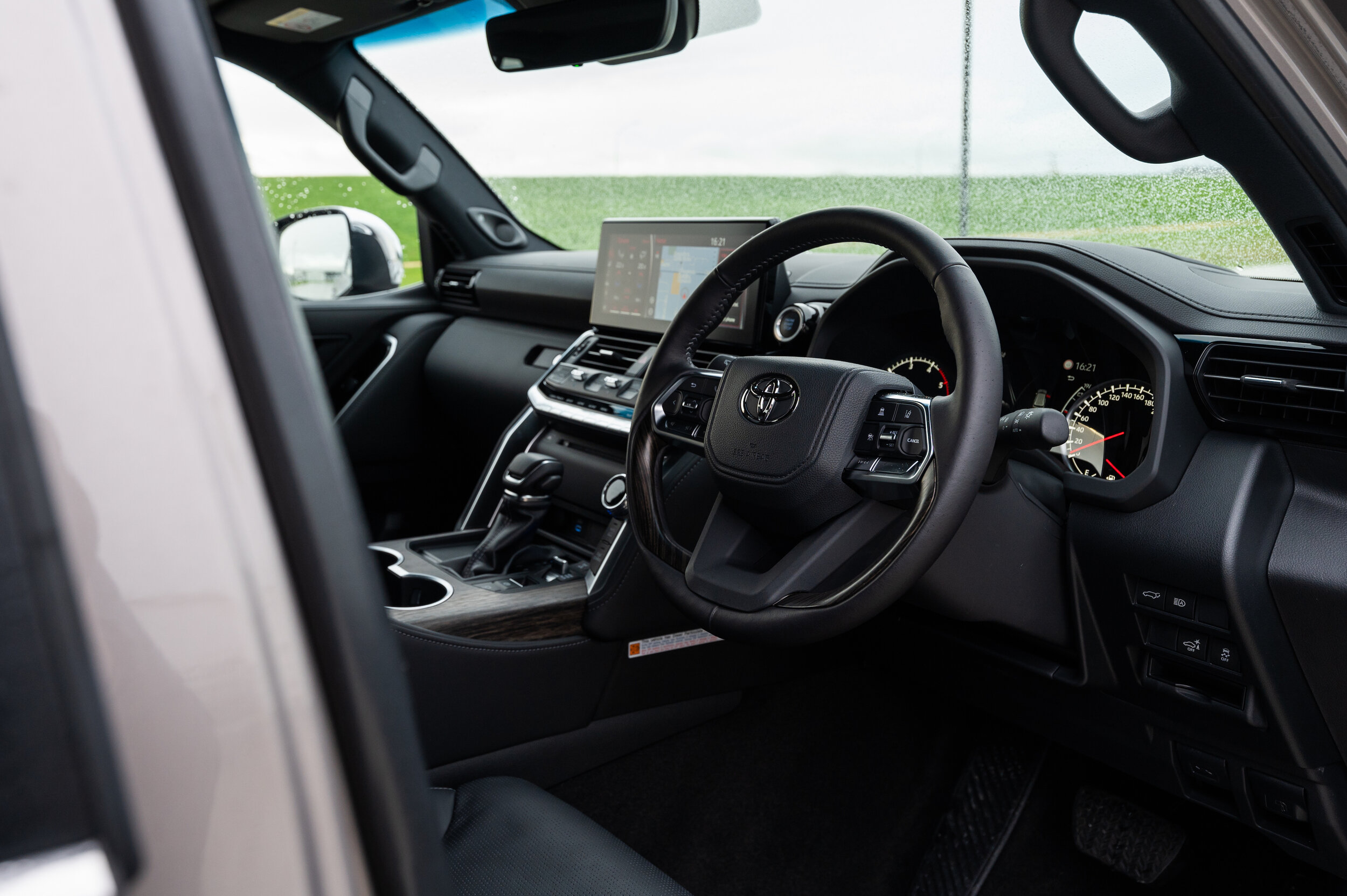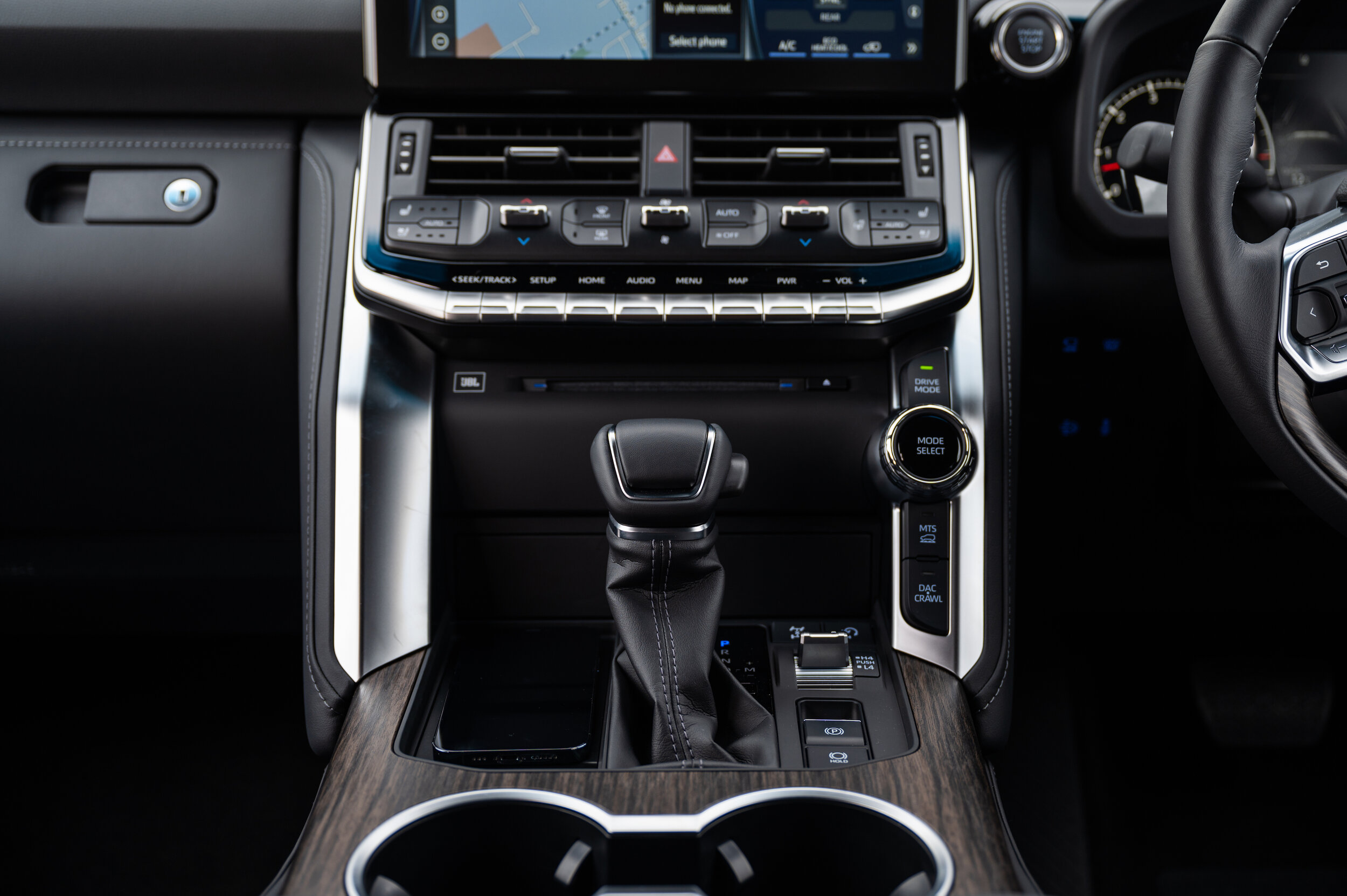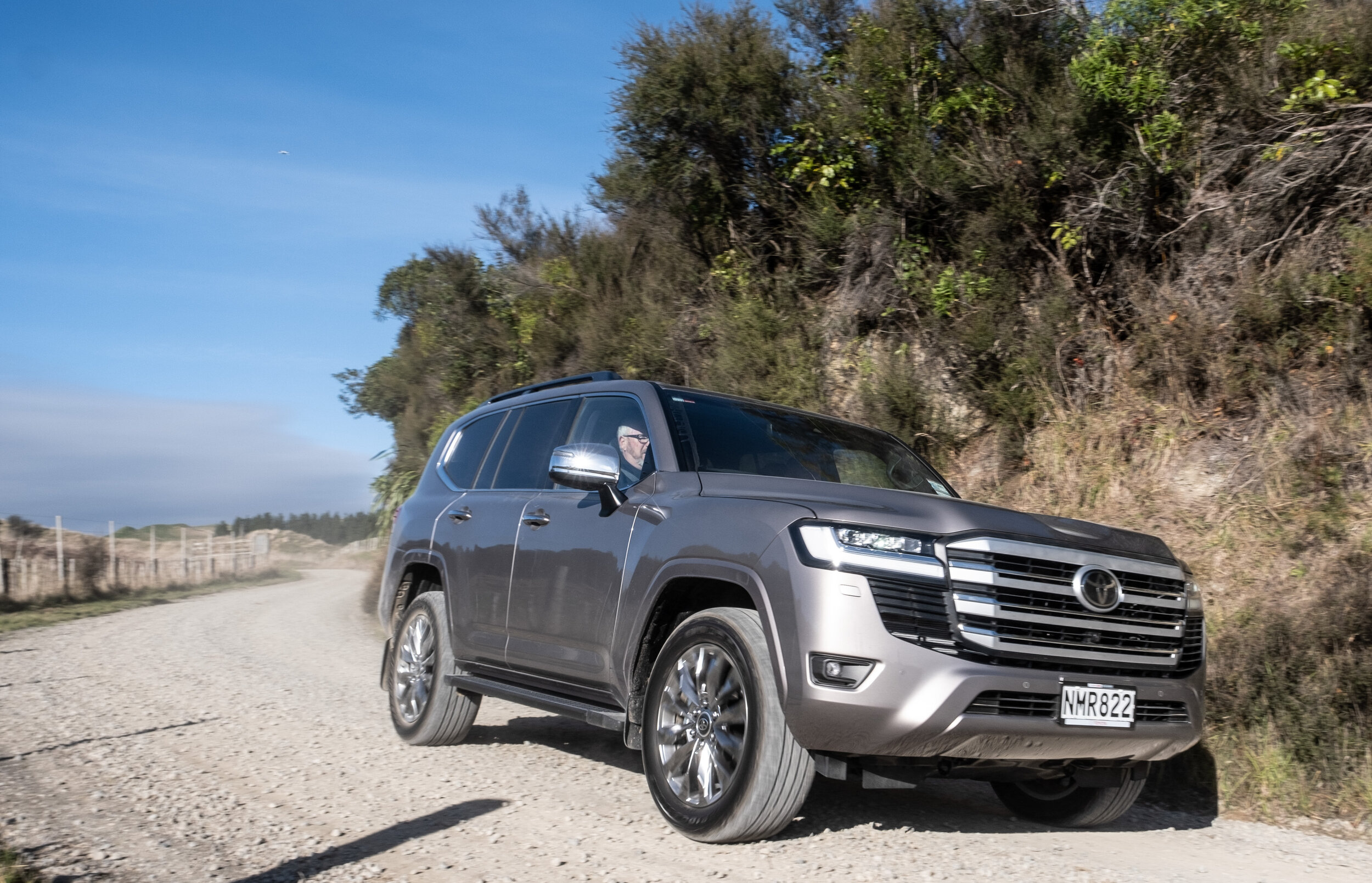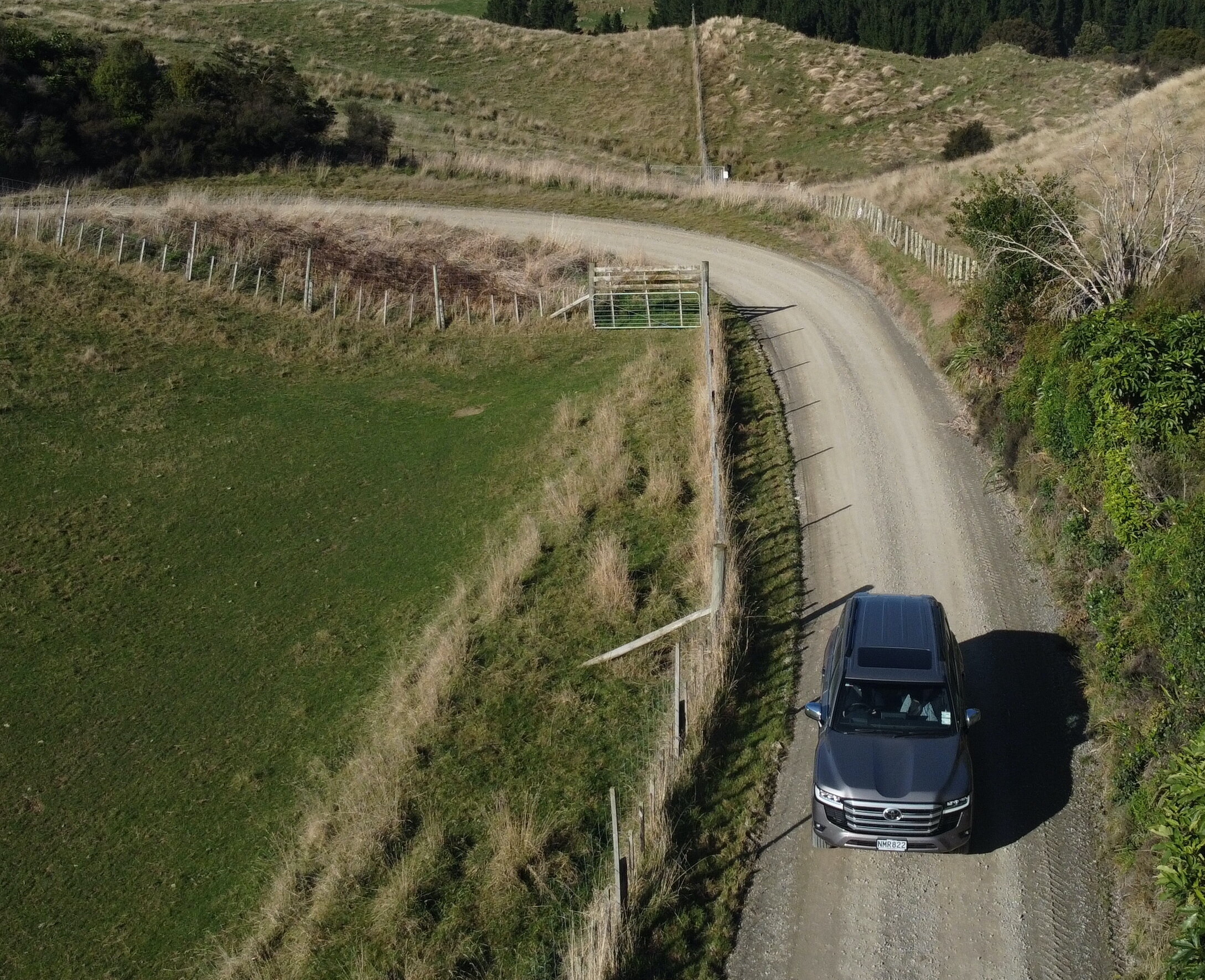Land Cruiser 300 Series first drive review: New, still familiar
/Toyota’s latest all-conditions SUV made its global debut today. Here’s how it goes on New Zealand roads.
THE only bloke seemingly at home in Apiti this morning was genuinely chuffed when told he was surely one of the first people not specifically associated with the car world to achieve an unexpurgated look at the new Land Cruiser 300.
Yet Ken was also bemused. How was it that a vehicle, announced to the world at a live event staged in the Middle East at 7am here, could have transplanted just four hours later to the main – well, pretty much only - street in this rural Manawatu backwater (population 226 and a friendly small black dog)?
The complexities of that questions take a bit of unravelling. Basically, it goes like this.
The latest generation of Toyota’s largest passenger model and longest-lived name plate has been in production for some months, but only in limited count and those examples have been kept away from public scrutiny, only being revealed officially from Japan today.
With that to-the-minute timing known, Toyota New Zealand decided it could synch-in a special outing for the sole example of the new model in the country.
I and three other journalists were invited to spend this morning driving their VX Limited ‘goshi’ – that’s an in-house parlance for a vehicle that is pre-production, but exactly to showroom standard, with the finish, fitout and capabilities expected of a model with an enviable reputation for on-road refinement, off-road performance, reliability and durability.
Anyway, the drive from Palmerston North, TNZ’s home town, up around the Pohangina Valley then back through a smattering regional villages is a good first taster; plenty of country roads, sealed and gravel.
Everything but off-road. It was hard having to drive past, without going into, Makoura Lodge, whose bespoke off-roading area has previously been a fun and brand-favoured place to test mud-attuned Toyotas. Plenty of SUVs do okay on formed routes; few are as historically adept at forging their own tracks through untamed territories as this Toyota. Not today, sadly. With just one in the country, and plenty of promotional work ahead, the risk to a vehicle registered just last Wednesday and with just 100km on the clock prior to this tour was too great.
I’m not sour about that. Honestly, getting to more than double that mileage with a morning’s driving was an amazing opportunity in its own right. And while just a taster, those 145kms were quite enough to relate one core factor. Namely, as much as everything has changed – not least under the bonnet (yes, goodbye 4.5-litre V8, hello 3.3-litre V6, also twin turboed) - there’s nothing to tell that you wouldn’t have expected to hear.
What we’ll see in the showroom from October, in three trim levels – below the version we drove there’s a VX, also in seven seat form, and above a family-new GR Sport flagship with five chairs – pricing yet to be shared (though hope is to not bump up more than $10,000 from the respective stickers on the outgoing $115,990 VX and $129,990 VX Limited) is very much wholly new.
Everything Toyota says it has learnt building four-wheel-drive vehicles has gone into the design, development and manufacturing of a vehicle whose seven year development has delivered a new platform, called TNGA-F, that maintains – to protect “its off-road core” - a ladder frame structure, that new drivetrain (destined to share with other, as yet unspecified ‘premium’ heavy duty products) and more advanced driving assist and safety technologies.
Of course, it’s only so much of a fresh start … there’s absolutely no trouble associating it with the outgoing 200-Series born in 2007 and refitted in 2015 or even, for that matter, the 100-Series that emerged late last century.
Calling it modern ‘old school’ is not an intended slight. A commonality in fundamental function is the fuel that has kept the Land Cruiser going for 70 years – a duration that makes it the longest-produced vehicle in Toyota history.
Yes, it puts a foot into the future with more than the engine swap; being also technically smarter and rendering most of the exterior panels out of alloy cuts 110kg out of body weight; though it’s still a burly fella at 2630kg.
The shaping having become blockier – but no bigger, every external proportion being identical save length (down 5mm) – seems to be more about design whim than improving aero function.
The push to bring it back to modernity realises most strongly with the cabin design, which has become hugely swisher and far more logical (just as well, the old’s button placement was laughably sporadic), even though the area around the stubby gearstick - yes, it still has one of those - is rather busy.
The technical highpoint is the central 12.5-inch screen with better resolution and reactivity than the old nine-incher, and capability to at last run Apple CarPlay and Android, but modern families on the move will like that it has more USB (and even a USC) ports plus a gigantic induction charging pad. At same token, the entertainment screens fixed to the back of each front seat seem a weird investment. Why go to all that trouble in the age of the iPad? Likewise a CD/DVD player at a time when those media are fast disappearing from sale? Really??
The driver benefits from improved instrumentation, complete with a head-up display, and a better driving position (don’t fear the smaller steering wheel, it’s fine).
Though interior space for seated occupants seems much the same, and everyone sits quite high, the chairs are better-shaped and comfortable, the driver’s being more body-hugging, so no more slipping around in corners; a bonus when all seat coverings are leather (or, in the VX, leather-like). It’s no surprise the rearmost pews that no longer stow into the cabin sides but fold flat into the floor are really still for kids; that a much larger boot results is the good news from that change.
What’s most important to know is that as sad it is to have to farewell the legendary V8 from the wagon – it’s still available in the 70-Series, albeit in single turbo form – neither is that a bad thing all in all.
The on paper appeal of power and torque outputs of 225kW and 700Nm, against 200kW and 650Nm, is genuinely felt on the road. The six is simply more athletic and energised and marriage with this 10-speed gearbox is far more harmonious than the V8’s was with the preceding six-speed. The new box allows this engine operate much more effectively over a much broader rev span; it’s smooth and schmoozy.
Toyota has yet to release a 0-100kmh time; our impromptu tilt suggests it could be around nine seconds to the legal highway limit from a standing start, this without resorting to the transmission’s sport modes. Not bad, surely?
Of course, the real reason Toyota has bet big on a new engine and transmission, each representing as ‘firsts’ for this brand (so, first ever twin turbo six, first ever 10 speed), was to improve the old car’s poor economy and emissions performance. Toyota admits there was just no way of getting better figures for either out of the old engine.
How’s it doing now? Ours was no economy run, yet while cited optimal fuel burn improvement might seem to be marginal, with 8.9 litres per 100km claimed now representing a 0.6L/100km improvement on before, the instant return figures suggest it has stronger potential to be a more obviously leaner performer. Reduction of soot output from a dirty 309 grams per kilometre to an almost Hilux-matching 235g/km is a big feat, too; even when booted hard, there didn’t seem to be any black tell-tale from the pipes.
How the drivetrain performs off-road will be fascinating; that maximum torque is generating at only 1600rpm bodes as well for its ability to cope with serious mucking in as do the other core attributes of the permanent four-wheel-drive that now allows selection of any driving condition mode at any speed, the 700mm wading depth, 235mm ground clearance and respective 32 and 25 degree approach and departure angles.
On our drive, the VX Limited impressed for delivering refinement and also for relatively quick-witted reflexes; sure, it’s pretty obvious there’s plenty of weight still to haul, and body roll and significant tyre squeal still evidences when you push beyond a certain point.
At same token, it was massively revealing to see how our vehicle was sometimes far less unsettled in that respect than the 200-Series lead car and, quite probably, had superior grip from its tyres, in this instance 265/55 Dunlop Grand Trek AT30 Touring rubber, on 20-inch rims (which VX Limited alone has, the others being on 18-inchers). It felt confident on gravel as well, with the stability assist interceding smoothly when then nose began to wash out on a tightening bend.
Other technical revisions also tend to play positively. The speed sensitive cruise control used to cut out at 30kmh on the 200 Series; now it not only runs down to zero but, when the vehicle is at a standstill, it has facility to move off again with the traffic stream – either on its own accord if the delay is than three seconds or with a mere button prompt if the dwell time is longer.
The Toyota Safety Sense package now including cyclist detection and also a intersection turn assistance, with ability to intercede if a potential collision is detected, will surely be useful in city driving. Also, it ups its detection talent when parking. The one function that is a bit too nannyish is a cornering speed assist, with which the car can slow itself for bends without human intervention. The idea is well-meaning, but as in the latest Highlander, it’s too overbearing. In respect to the ‘s’ word; Land Cruiser’s safety record is solid but the brand might not know for some time yet how the 300 Series stands up to the vital ANCAP test. They believe it should get the optimal five stars.
Adaptive variable suspension figures in the whole range but the ultimate chassis control feature, an electronic version of the previous mechanical Kinetic Dynamic Suspension System, restricts to the GR Sport, which also stands as the sole choice with lockable front and rear differentials.
The diesel V6 is intended to be the sole choice in this Land Cruiser, though that’s not to say alternate twin-turbo V6 petrol, also backed by a 10-speed auto, that creates 305kW and 650Nm, might not show in any replacement for the Lexus LX 570, which presently runs a petrol V8 that’s far thirstier than the diesel.
There has been ongoing speculation about the 300 Series also achieving a hybrid drivetrain, which if Toyota tradition is continued would mean a marriage between a petrol engine, presumably of modest capacity, with a battery-fed electric motor. TNZ says it has no firm information about the potential for this coming into the market, but says it understands there is interest from the Middle East.
Land Cruiser’s extra-long life-cycles are vital for Toyota’s bottom line - the engineering effort alone makes these exorbitantly expensive types of vehicle to bring to the public - but ultimately it meant that the 200 Series was starting to fall way behind; the last big rejig, after all, was six years ago. No wonder the 300 Series feels so much better by comparison. If the same timeline replicates again, then the replacement for what we’re about to get could conceivably be ready at a point when New Zealand is preparing to say goodbye to fully fossil-fuelled passenger models.
The more relevant question might be if it feels modern enough. Compare it to the Land Rover Defender and you might have cause to wonder; the Brit model is surely a generation ahead in respect to its electronic cleverness. It also stands as the only other large, extra-robust vehicle designed primarily to excel off-road and deliver top-tier (3500kg) towing that lends relevant comparison. All the moreso now it has come out with a six-cylinder too.
Everything other SUV of this size or price level is based on a car platform, an approach many buyers no considers to be more amenable, not least when they’re based in the city, an environment that might prove as challenging to this Cruiser as it has to any of its predecessors.
Fortunately, suburbia is no longer the primary habitat. Those who complain about Parnell Tractors might be heartened to know that the days of this Toyota being a prized suburban trophy trucks are pretty much over.
Cruiser 200 sales hotspots have become generally provincial and that’s actually led to a resurgence. TNZ had some of the type’s top supporters, customers and dealers, at a special preview dinner last night and the reception was very positive; some signing up there and then.
Because build of NZ-market models doesn’t kick in until next month and launch isn’t until October 1, just 228 examples are coming here in 2021, out of which 100 will be in the VX Limited trim, which is perceived to be the most popular, and 68 in the new, yet unseen here, GR Sport fitout.
Next year’s allocation has already been settled at 600 units, which is a healthy count given that, for the past three years, the 200-Series has accrued between 300 and 400 units annually.























